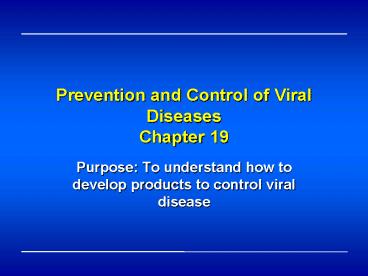Prevention and Control of Viral Diseases Chapter 19 - PowerPoint PPT Presentation
1 / 28
Title:
Prevention and Control of Viral Diseases Chapter 19
Description:
Prevention and Control of Viral Diseases. Chapter 19 ... Sabin vaccine. Measles vaccine. Recombinant DNA technology. Inactivated or 'killed' virus vaccines ... – PowerPoint PPT presentation
Number of Views:2065
Avg rating:3.0/5.0
Title: Prevention and Control of Viral Diseases Chapter 19
1
Prevention and Control of Viral DiseasesChapter
19
- Purpose To understand how to develop products to
control viral disease
2
Two methods
- Prevention of viral infections by vaccines
- Treatment of viral diseases with drugs
3
Caveats
- Any agent or process that blocks viral
replication or reduces pathogenesis - Imposes selection for viral mutants
- Select mutants may be able to bypass blocking
agent - As infection is intracellular, any intervention
affecting host enzyme or process will carry
inherent risksb
4
An example of success smallpox vaccine
- Result of smallpox disease
- death, disfigurement (crippling)
- 1/10 of humankind affected
- Chinese and Indian physicians 1st performed
variolation in 11th century - Jenner 1796
5
Problems with current smallpox
- Stockpile of Dryvax
- Passaged vaccinia
- Side effects
- AIDS, immunosuppressive drugs
- 2002 military, health care workers
6
Large scale vaccination
7
Requirements for eradication
- Viral infectious cycle must take place in one
host - Infection (or vaccination) must induce lifelong
immunity
8
Smallpox characteristics
9
Control of spread
- Identify and stop the spread from niche outbreaks
- ring-slaughter program slaughter every host
animal in farms at increasing distances
surrounding an outbreak site - Sometime may need to all animals on at-risk
farms
10
New vaccines
- Challenge cannot predict the efficacy or side
effects of vaccines - Lack knowledge of immune protection against most
viral infections - CTL?
- Antibody?
11
Vaccine basics
- Vaccines stimulate immune memory
- Presence of T and B lymphocytes that are
pathogen-specific after infection or vaccination - Vaccines must establish memory and immunity
without the pathogenic events - Immunization processes
- Active
- Passive products of the immune response
- Safe, efficacious and practical
- Herd-immunity- decrease threshold
- 80-95 population having immunity
12
Effective vaccines
13
Problems with weak immunity
- Protection against subsequent infection may be
inadequate - Viral replication may occur in the presence of
weak immune effectors - Mutants that can escape the hosts immune
response may be selected and transmitted to
population
14
Different types of vaccines
15
Live attenuated
- Passage in cell lines
- Temperature mutants
16
Sabin vaccine
17
Measles vaccine
18
Recombinant DNA technology
19
Inactivated or killed virus vaccines
- Treatment with formalin or extraction of
enveloped virus particles with nonionic
detergents - Accidents Salk polio vaccine
- Flu vaccine
20
Subunit vaccines
- Purified components of viruses
- Recombinant DNA technology- beneficial because
can produce only proteins of interest
21
Adjuvants
22
Delivery vehicles
23
Available vaccines
24
New vaccinia virus vectors
25
Epitope screening
26
DNA vaccines
27
DNA vaccines results
28
Immunotherapy candidates































![[PDF] Role of Birds in Transmitting Zoonotic Pathogens (Livestock Diseases and Management) 1st ed. 2021 Edition Kindle PowerPoint PPT Presentation](https://s3.amazonaws.com/images.powershow.com/10096760.th0.jpg?_=20240812016)